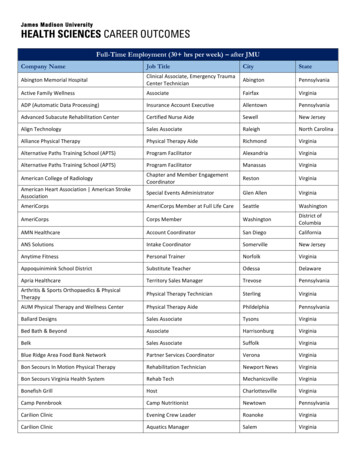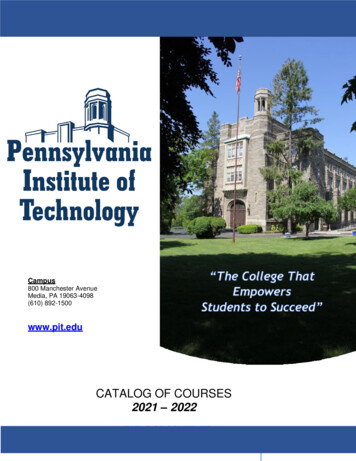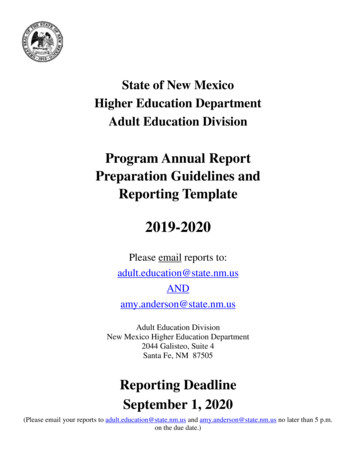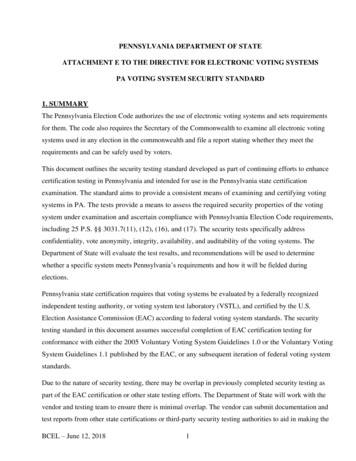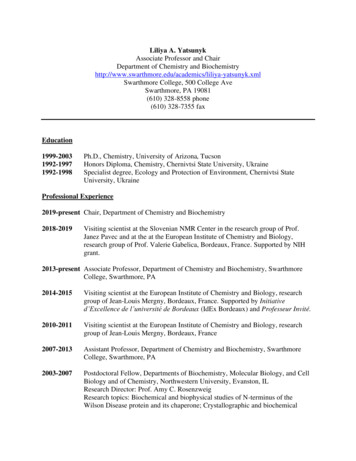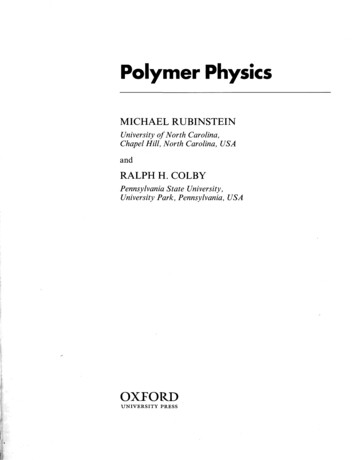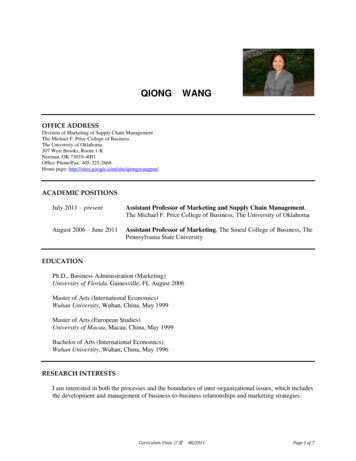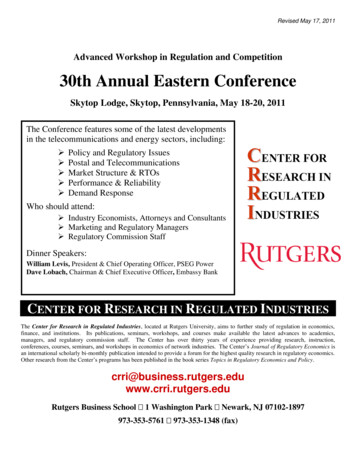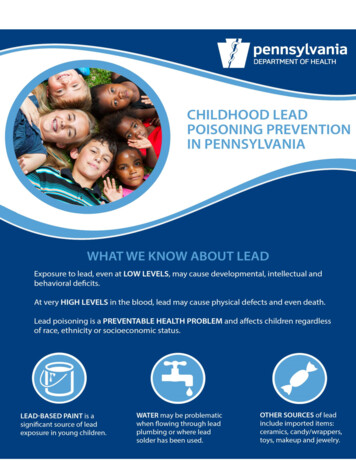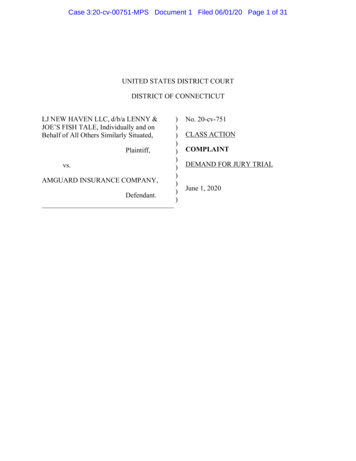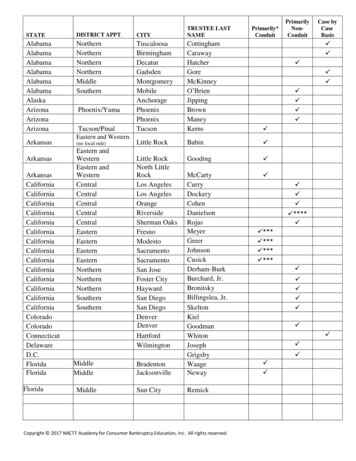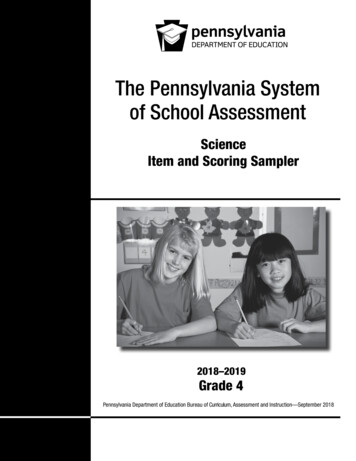
Transcription
The Pennsylvania Systemof School AssessmentScienceItem and Scoring Sampler2018–2019Grade 4Pennsylvania Department of Education Bureau of Curriculum, Assessment and Instruction—September 2018
TABLE OF CONTENTSINFORMATION ABOUT SCIENCEIntroduction. . . . . . . . . . . . . . . . . . . . . . . . . . . . . . . . . . . . . . . . . . . . . . . . . . . . . . . . . . . . . . . . . . . . . . . . . . . . . . . . . . . . . . . . 1What Is Included. . . . . . . . . . . . . . . . . . . . . . . . . . . . . . . . . . . . . . . . . . . . . . . . . . . . . . . . . . . . . . . . . . . . . . . . . . . . . . . . . . . . 1Purposes and Uses. . . . . . . . . . . . . . . . . . . . . . . . . . . . . . . . . . . . . . . . . . . . . . . . . . . . . . . . . . . . . . . . . . . . . . . . . . . . . . . . . . 1Item Format and Scoring Guidelines. . . . . . . . . . . . . . . . . . . . . . . . . . . . . . . . . . . . . . . . . . . . . . . . . . . . . . . . . . . . . . . . . 1Testing Time and Mode of Testing Delivery for the PSSA. . . . . . . . . . . . . . . . . . . . . . . . . . . . . . . . . . . . . . . . . . . . . . 1Item and Scoring Sampler Format. . . . . . . . . . . . . . . . . . . . . . . . . . . . . . . . . . . . . . . . . . . . . . . . . . . . . . . . . . . . . . . . . . . 2Science Test Directions. . . . . . . . . . . . . . . . . . . . . . . . . . . . . . . . . . . . . . . . . . . . . . . . . . . . . . . . . . . . . . . . . . . . . . . . . . . . . . 3General Description of Scoring Guidelines for Science Open-Ended Items. . . . . . . . . . . . . . . . . . . . . . . . . . . . . 4Multiple-Choice Questions. . . . . . . . . . . . . . . . . . . . . . . . . . . . . . . . . . . . . . . . . . . . . . . . . . . . . . . . . . . . . . . . . . . . . . . . . . 6Open-Ended Item. . . . . . . . . . . . . . . . . . . . . . . . . . . . . . . . . . . . . . . . . . . . . . . . . . . . . . . . . . . . . . . . . . . . . . . . . . . . . . . . . 26Item-Specific Scoring Guideline. . . . . . . . . . . . . . . . . . . . . . . . . . . . . . . . . . . . . . . . . . . . . . . . . . . . . . . . . . . . . . . 27Open-Ended Item. . . . . . . . . . . . . . . . . . . . . . . . . . . . . . . . . . . . . . . . . . . . . . . . . . . . . . . . . . . . . . . . . . . . . . . . . . . . . . . . . 33Item-Specific Scoring Guideline. . . . . . . . . . . . . . . . . . . . . . . . . . . . . . . . . . . . . . . . . . . . . . . . . . . . . . . . . . . . . . . 34Sample Item Summary. . . . . . . . . . . . . . . . . . . . . . . . . . . . . . . . . . . . . . . . . . . . . . . . . . . . . . . . . . . . . . . . . . . . . . . . . . . . 40PSSA Grade 4 Science Item and Scoring Sampler—September 2018ii
INFORMATION ABOUT SCIENCEINTRODUCTIONThe Pennsylvania Department of Education (PDE) provides districts and schools with tools to assist in deliveringfocused instructional programs aligned with the Pennsylvania Academic Standards (PAS). In addition to the PAS, thesetools include Assessment Anchor documents, assessment handbooks, and content-based item and scoring samplers.Each Item and Scoring Sampler is a useful tool for Pennsylvania educators in preparing local instructional programsand can also be useful in preparing students for the statewide assessment.This Item and Scoring Sampler is available in Braille format. For more information regarding Braille, call (717) 901-2238.WHAT IS INCLUDEDThis sampler contains test questions, or test “items,” that have been written to align to the Assessment Anchors that arebased on the PAS. The sample test questions model the types of items that will appear on an operational PSSA. Eachsample test question has been through a rigorous review process to ensure alignment with the Assessment Anchorsprior to being piloted in an embedded field test within a PSSA assessment and then used operationally on a PSSAassessment. Answer keys, scoring guidelines, and any related stimulus material are also included. Additionally, samplestudent responses are provided with each open-ended item to demonstrate the range of responses that studentsprovided in response to these items.PURPOSES AND USESThe items in this sampler may be used as models for creating assessment items at the classroom level, and they mayalso be copied and used as part of a local instructional program.1 Classroom teachers may find it beneficial to havestudents respond to the open-ended items in this sampler. Educators can then use the item’s scoring guideline andsample responses as a basic guide to score the responses, either independently or together with colleagues withina school or district. The sampler also includes the General Description of Scoring Guidelines for Science Open-EndedItems used to develop the item-specific guidelines. The general description of scoring guidelines can be used if anyadditional item-specific scoring guidelines are created for use within local instructional programs.1ITEM FORMAT AND SCORING GUIDELINESThe multiple-choice (MC) questions have four answer choices. Each correct response to an MC question is worthone point.Each open-ended (OE) item in science is scored using an item-specific scoring guideline based on a 0–2 point scale.TESTING TIME AND MODE OF TESTING DELIVERY FOR THE PSSAThe PSSA is delivered in traditional paper-and-pencil format as well as in an online format. The estimated time torespond to a test question is the same for both methods of test delivery. During an official testing administration,students are given additional time as necessary to complete the test questions. The following table shows theestimated response time per item for each item type.1Science Item TypeMCOEEstimated Response Time(minutes)15The permission to copy and/or use these materials does not extend to commercial purposes.PSSA Grade 4 Science Item and Scoring Sampler—September 20181
INFORMATION ABOUT SCIENCEITEM AND SCORING SAMPLER FORMATThis sampler includes the test directions and scoring guidelines that appear in the PSSA science assessments. Eachsample multiple-choice question is followed by a table that includes the alignment, the answer key, the depth ofknowledge (DOK) level, the percentage2 of students who chose each answer option, and a brief answer-optionanalysis or rationale. Each open-ended item is followed by a table that includes the item alignment, DOK, and meanstudent score. Additionally, each of the included item‐specific scoring guidelines is combined with sample studentresponses representing each score point to form a practical, item‐specific scoring guide. The General Description ofScoring Guidelines for Science Open-Ended Items used to develop the item‐specific scoring guidelines should be used ifany additional item‐specific scoring guidelines are created for use within local instructional programs.Example Multiple-Choice Question Information TableItem InformationAlignmentAnswer KeyDepth of Knowledgep-value Ap-value Bp-value Cp-value DOption AnnotationsAssigned AAECCorrect AnswerAssigned DOKPercentage of students who selected option APercentage of students who selected option BPercentage of students who selected option CPercentage of students who selected option DBrief answer-option analysis or rationaleExample Open-Ended Item Information TableAlignment2Assigned AAECDepth of KnowledgeAssigned DOKMean ScoreAll p-value percentages listed in the item information tables have been rounded.PSSA Grade 4 Science Item and Scoring Sampler—September 20182
PSSA SCIENCE GRADE 4SCIENCE TEST DIRECTIONSOn the following pages are the Science questions. There are two types of questions.Multiple-Choice Questions:Some questions will ask you to select an answer from among four choices. These questionswill be found in your test booklet.For the multiple-choice questions: Read each question, and choose the best answer. Record your choice in the answer booklet. Only one of the answers provided is the correct response.Open-Ended Questions:Other questions will require you to write your response. These questions will be foundin your answer booklet.For the open-ended questions: Be sure to read the directions carefully. If the question asks you to do two tasks, be sure to complete both tasks. If the question asks you to compare, be sure to compare. Also, if the questionasks you to explain, describe, or identify, be sure to explain, describe, oridentify.PSSA Grade 4 Science Item and Scoring Sampler—September 20183
PSSA SCIENCE GRADE 4GENERAL DESCRIPTION OF SCORING GUIDELINES FOR SCIENCE OPEN-ENDED ITEMS2 Points The response demonstrates a thorough understanding of the scientific content, concepts, and proceduresrequired by the task(s). The response provides a clear, complete, and correct response as required by the task(s). The response maycontain a minor blemish or omission in work or explanation that does not detract from demonstrating athorough understanding.1 Point The response demonstrates a partial understanding of the scientific content, concepts, and procedures requiredby the task(s). The response is somewhat correct with partial understanding of the required scientific content, concepts,and/or procedures demonstrated and/or explained. The response may contain some work that is incompleteor unclear.0 Points The response provides insufficient evidence to demonstrate any understanding of the scientific content,concepts, and procedures as required by the task(s) for that grade level. The response may show only information copied or rephrased from the question or insufficient correctinformation to receive a score of 1.Special Categories within zero reported separately:Blank.Blank, entirely erased, entirely crossed out, or consists entirely of whitespaceRefusal.Refusal to respond to the taskOff Task.Makes no reference to the item but is not an intentional refusalForeign Language.Written entirely in a language other than EnglishIllegible.Illegible or incoherentPSSA Grade 4 Science Item and Scoring Sampler—September 20184
PSSA SCIENCE GRADE 4THIS PAGE ISINTENTIONALLY BLANK.PSSA Grade 4 Science Item and Scoring Sampler—September 20185
PSSA SCIENCE GRADE 4MULTIPLE-CHOICE QUESTIONS1.Over the past hundred years, people have built new and better roads in Pennsylvania. What isone possible negative effect of this technology?A.Transportation has become less expensive.B.Traveling greater distances is more difficult.C.Wildlife habitats are separated into smaller areas.D.Mail delivery services take longer to reach people.Item InformationAlignmentAnswer KeyS4.A.1.1.2CDepth of Knowledgep-value Ap-value Bp-value Cp-value D211%16%63% (correct answer)10%Option AnnotationsA. Decreased expense would be a positive effect, not a negative effect.B. New and better roads make traveling greater distances easier, not moredifficult.C. Key: Roads can separate wildlife habitats into smaller areas and negativelyimpact species that live in the areas.D. New and better roads allow mail to be delivered more quickly, not moreslowly.PSSA Grade 4 Science Item and Scoring Sampler—September 20186
PSSA SCIENCE GRADE 42.Use the drawings below to answer the question.Sunrise and Sunset Times for Erie, PA(January 1)A.M.P.M.sunsetsunriseSunrise and Sunset Times for Erie, PA(May 1)P.M.A.M.sunrisesunsetWhich change occurred between January 1 and May 1?A.The amount of daylight increased.B.The average air temperature decreased.C.Earth rotated more quickly around its axis.D.Earth made one revolution around the Sun.Item InformationAlignmentAnswer KeyS4.A.1.3.1ADepth of Knowledgep-value Ap-value Bp-value Cp-value D265% (correct answer)7%16%12%Option AnnotationsA. Key: The time between sunrise and sunset increased between January 1and May 1.B. The drawings show times, not temperatures.C. The speed of Earth’s rotation does not change during the year.D. Earth makes one revolution around the Sun in one year, not in four months.PSSA Grade 4 Science Item and Scoring Sampler—September 20187
PSSA SCIENCE GRADE 43.A student wants to measure the depth of each snowfall in January. Which tools are most helpfulfor gathering and recording the data?A.shovel and calculatorB.beaker and stopwatchC.balance and computerD.meterstick and calendarItem InformationAlignmentAnswer KeyS4.A.1.3.1DDepth of Knowledgep-value Ap-value Bp-value Cp-value D215%11%10%64% (correct answer)Option AnnotationsA. Neither a shovel nor a calculator is a tool for measuring.B. A beaker can be used to measure volume, but not length. A stopwatchcan be used to measure time in seconds and minutes, but not days andmonths.C. A balance can be used to measure mass. A computer is not a tool formeasuring.D. Key: The meterstick will allow the student to record the depth of snow incentimeters, and the calendar will allow the student to record the day of themonth.PSSA Grade 4 Science Item and Scoring Sampler—September 20188
PSSA SCIENCE GRADE 44.Use the drawing below to answer the question.FlashlightA student wants to compare how long a flashlight will continue to shine using different brands ofbatteries. How can the student make sure that the test is fair?A.Test the same brand of batteries in two flashlights.B.Test each brand of batteries in the same flashlight.C.Test different sizes of batteries in the same flashlight.D.Test whether some flashlights can work with only one battery.Item InformationAlignmentAnswer KeyS4.A.2.1.2BDepth of Knowledgep-value Ap-value Bp-value Cp-value D324%54% (correct answer)11%11%Option AnnotationsA. The student wants to compare different brands of batteries, not the samebrand.B. Key: Using different brands of batteries in the same flashlight will limit thenumber of variables.C. Only one size of battery will work in the flashlight.D. The student wants to compare different brands of batteries, not differentflashlights.PSSA Grade 4 Science Item and Scoring Sampler—September 20189
PSSA SCIENCE GRADE 45.Use the table below to answer the question.Student ObservationsYearArrival Date of Merganser Ducks1February 222March 33March 104February 28A student observes the first day merganser ducks arrive at a lake each year during theirmigration. When will the merganser ducks most likely arrive at the lake in year 5?A.February 15 to 22B.around February 15C.mid-April to late AprilD.late February to mid-MarchItem InformationAlignmentAnswer KeyS4.A.2.1.3DDepth of Knowledgep-value Ap-value Bp-value Cp-value D214%11%21%54% (correct answer)Option AnnotationsA. The earliest that merganser ducks have been observed is February 22, so itis unlikely that they will arrive before this date.B. The earliest that merganser ducks have been observed is February 22, so itis unlikely that they will arrive before this date.C. The merganser ducks were observed arriving between February 22 andMarch 10, so it is unlikely they will arrive as late as April.D. Key: The merganser ducks have been observed arriving at the lake betweenFebruary 22 and March 10 in previous years, so they will most likelycontinue this pattern in future years.PSSA Grade 4 Science Item and Scoring Sampler—September 201810
PSSA SCIENCE GRADE 46.Which system is partly natural and partly human-made?A.a pen that writes in blue inkB.a tree that produces edible fruitC.a mountain that erodes over timeD.a coral reef that grows on old train carsItem InformationAlignmentAnswer KeyS4.A.3.1.1DDepth of Knowledgep-value Ap-value Bp-value Cp-value D228%23%8%41% (correct answer)Option AnnotationsA.B.C.D.Both the pen and ink are human-made.Both the tree and fruit are natural.Both the mountain and the process of erosion are natural.Key: The coral reef is natural and the train cars are human-made.PSSA Grade 4 Science Item and Scoring Sampler—September 201811
PSSA SCIENCE GRADE 47.A student described human-made systems and natural systems. Which characteristic wasmost likely used to describe both systems?A.grows largerB.needs oxygenC.has multiple partsD.is powered by electricityItem InformationAlignmentAnswer KeyS4.A.3.1.1CDepth of Knowledgep-value Ap-value Bp-value Cp-value D214%31%41% (correct answer)14%Option AnnotationsA.B.C.D.Human-made systems do not grow larger.Human-made systems do not need oxygen.Key: Both human-made systems and natural systems have multiple parts.Natural systems are not powered by electricity.PSSA Grade 4 Science Item and Scoring Sampler—September 201812
PSSA SCIENCE GRADE 48.Use the drawing below to answer the question.TerrariumplantssoilHow does the soil help the plants in the terrarium?A.The soil absorbs sunlight for the plants.B.The soil produces energy for the plants.C.The soil provides the plants with a place to grow.D.The soil protects the plants from other organisms.Item InformationAlignmentAnswer KeyS4.A.3.1.2CDepth of Knowledgep-value Ap-value Bp-value Cp-value D218%25%47% (correct answer)10%Option AnnotationsA. Plants absorb sunlight to grow. They do not get sunlight from the soil.B. Plants make their own energy from sunlight, water, and carbon dioxide.They do not get energy from the soil.C. Key: Plants grow in soil.D. The soil does not protect the plants from other organisms.PSSA Grade 4 Science Item and Scoring Sampler—September 201813
PSSA SCIENCE GRADE 49.How do the human nose and lungs work together?A.The nose filters air that is processed in the lungs.B.The nose brings in food that is digested in the lungs.C.The nose lets out energy that is produced by the lungs.D.The nose senses odors that are understood by the lungs.Item InformationAlignmentAnswer KeyS4.B.1.1.4ADepth of Knowledgep-value Ap-value Bp-value Cp-value D264% (correct answer)6%16%14%Option AnnotationsA. Key: Air is inhaled through the nose, filtered, and then processed in thelungs.B. The nose and lungs are part of the respiratory system, not the digestivesystem.C. The nose filters air that is processed in the lungs. The nose does not let outenergy that is produced by the lungs.D. The nose has sensors that receive information about smells, but thisinformation is processed by the brain, not the lungs.PSSA Grade 4 Science Item and Scoring Sampler—September 201814
PSSA SCIENCE GRADE 410. Use the lists below to answer the question.Lists of TraitsList AList B brown eyes5 feet tall scar on right kneelikes to sing curly hair long hairHow are these lists of traits different?A.Only the traits in List A can change.B.Only the traits in List B are formed naturally.C.Only the traits in List A are inherited from parents.D.Only the traits in List B can affect a person’s survival.Item InformationAlignmentAnswer KeyS4.B.2.2.1CDepth of Knowledgep-value Ap-value Bp-value Cp-value D214%18%57% (correct answer)11%Option AnnotationsA.B.C.D.The traits in both lists can change over time.The traits in both lists can be formed naturally.Key: The traits in List A are controlled by genes passed on from the parents.The traits in List B would be unlikely to affect a person’s survival.PSSA Grade 4 Science Item and Scoring Sampler—September 201815
PSSA SCIENCE GRADE 4Number of Daylight Hours11. Use the graph below to answer the question.Average Number of Daylight Hours in Pennsylvania during a Year24201612840JanFeb MarApr May Jun JulMonthAug Sep Oct Nov DecPlants and animals respond to changes in their natural environment. Which natural responsecan most likely be predicted due to the changing amounts of daylight shown in the graph?A.Birds will migrate north between July and December.B.Birds will migrate south between January and March.C.Plants will absorb the most energy between May and July.D.Plants will absorb the most energy between March and May.Item InformationAlignmentAnswer KeyS4.B.3.2.3CDepth of Knowledgep-value Ap-value Bp-value Cp-value D320%20%49% (correct answer)11%Option AnnotationsA. Birds migrate south, not north, between July and December.B. Birds migrate north, not south, between January and March.C. Key: The numbers of hours of daylight are greatest between May and July,allowing plants to absorb the most energy during this time.D. The numbers of hours of daylight are greatest between May and July, notbetween March and May.PSSA Grade 4 Science Item and Scoring Sampler—September 201816
PSSA SCIENCE GRADE 412. A log burns in a fireplace. Nearby, a light bulb is glowing. How are the fire and the light bulbalike?A.Both create new energy.B.Both absorb light energy.C.Both release light energy.D.Both use electrical energy.Item InformationAlignmentAnswer KeyS4.C.2.1.2CDepth of Knowledgep-value Ap-value Bp-value Cp-value D210%13%70% (correct answer)7%Option AnnotationsA.B.C.D.Energy is not created by either the fire or the light bulb.Both sources release light energy. They do not absorb it.Key: The fire and the light bulb both release energy in the form of light.The fire does not use electrical energy.PSSA Grade 4 Science Item and Scoring Sampler—September 201817
PSSA SCIENCE GRADE 413. Use the drawing below to answer the question.Schoolyard PlaygroundA schoolyard playground reminded a student of an electrical circuit. Which type of circuit wouldthe student most likely describe using the playground?A.a series circuit because there is only one way up to the topB.a series circuit because the students can only go down the slidesC.a parallel circuit because the students change directions as they are playingD.a parallel circuit because students have two ways to slide down to the groundPSSA Grade 4 Science Item and Scoring Sampler—September 201818
PSSA SCIENCE GRADE 4Item InformationAlignmentAnswer KeyS4.C.2.1.3DDepth of Knowledgep-value Ap-value Bp-value Cp-value D323%12%13%52% (correct answer)Option AnnotationsA. The circuit is parallel, not series, because there is more than one path to theground.B. The circuit is parallel, not series, because there is more than one path to theground.C. The arrows do not indicate that the students can change direction whileplaying.D. Key: Parallel circuits have more than one path for the current to flow; thetwo slides show this split.PSSA Grade 4 Science Item and Scoring Sampler—September 201819
PSSA SCIENCE GRADE 414. Use the drawing below to answer the question.Student Playing Basketballtime 1time 2Which statement best describes the movement of the student and the ball in the drawing?A.The student is only moving from side to side, while the basketball is only moving up anddown.B.The student is mostly moving up and down, while the basketball is mostly moving from sideto side.C.The student is only moving up and down, while the basketball is moving up and down andfrom side to side.D.The student is mostly moving from side to side, while the basketball is moving from side toside and up and down.PSSA Grade 4 Science Item and Scoring Sampler—September 201820
PSSA SCIENCE GRADE 4Item InformationAlignmentAnswer KeyS4.C.3.1.2DDepth of Knowledgep-value Ap-value Bp-value Cp-value D222%10%11%57% (correct answer)Option AnnotationsA. The basketball is also moving from side to side, not just up and down.B. The student is moving from side to side, not up and down. Also, thebasketball is moving up and down and from side to side.C. The student is moving from side to side, not up and down.D. Key: The student is moving from side to side, and the basketball is movingboth up and down and from side to side.PSSA Grade 4 Science Item and Scoring Sampler—September 201821
PSSA SCIENCE GRADE 415. A student lives near a lake. Which observation is the student most likely to make aboutthe lake?A.The water is fresh rather than salty.B.The lake empties into a larger body of water.C.The water flows quickly from high to low areas.D.The lake completely dries up during some seasons.Item InformationAlignmentAnswer KeyS4.D.1.3.1ADepth of Knowledgep-value Ap-value Bp-value Cp-value D249% (correct answer)20%20%11%Option AnnotationsA.B.C.D.Key: Most lakes contain fresh water.Rivers, not lakes, empty into larger bodies of water.Lakes contain still water. They do not flow.Lakes are usually too large to completely dry up.PSSA Grade 4 Science Item and Scoring Sampler—September 201822
PSSA SCIENCE GRADE 4THIS PAGE ISINTENTIONALLY BLANK.PSSA Grade 4 Science Item and Scoring Sampler—September 201823
PSSA SCIENCE GRADE 416. Use the weather map below to answer the question.SeattleHPhiladelphiaChicagoSan JoseLos AngelesDenverLEl PasoMemphisHoustonJacksonvilleHKey cold front warm frontWhich type of front is likely to arrive soon in Philadelphia?A.cold front from the northB.cold front from the southC.warm front from the northD.warm front from the southPSSA Grade 4 Science Item and Scoring Sampler—September 201824
PSSA SCIENCE GRADE 4Item InformationAlignmentAnswer KeyS4.D.2.1.2DDepth of Knowledgep-value Ap-value Bp-value Cp-value D211%10%35%44% (correct answer)Option AnnotationsA.B.C.D.There is no cold front to the north of Philadelphia.There is no cold front to the south of Philadelphia.There is no warm front to the north of Philadelphia.Key: There is a warm front to the south of Philadelphia, and it will most likelymove northeast and affect Philadelphia.PSSA Grade 4 Science Item and Scoring Sampler—September 201825
PSSA SCIENCE GRADE 4OPEN-ENDED ITEM17. Use the drawing below to answer the question.Birds at a Bird FeederA student wants to learn more about birds. The student fills and hangs a bird feederfrom a tree outside a window.Part A: Identify an appropriate tool for measuring how much bird seed is eaten fromthe feeder each day.Part B: Describe how using binoculars can help the student learn more about thebirds that visit the feeder.PSSA Grade 4 Science Item and Scoring Sampler—September 201826
PSSA SCIENCE GRADE 4SCORING GUIDE#17 Item InformationAlignmentS4.A.2.2.1Depth of Knowledge2Mean Score1.50Item-Specific Scoring GuidelineScore210DescriptionThe response demonstrates a thorough understanding of how to identify appropriate tools orinstruments for specific tasks and describes the information they can provide (e.g., measuring:length – ruler, mass – balance scale, volume – beaker, temperature – thermometer, makingobservations: hand lens, binoculars, telescope) by identifying an appropriate tool for measuring how much bird seed is eaten from the feedereach dayand describing how using binoculars can help the student learn more about the birds that visitthe feeder.The response is clear, complete, and correct.The response demonstrates a partial understanding of how to identify appropriate tools orinstruments for specific tasks and describes the information they can provide (e.g., measuring:length – ruler, mass – balance scale, volume – beaker, temperature – thermometer, makingobservations: hand lens, binoculars, telescope) by identifying an appropriate tool for measuring how much bird seed is eaten from the feedereach dayor describing how using binoculars can help the student learn more about the birds that visitthe feeder.The response may contain some work that is incomplete or unclear.The response provides insufficient evidence to demonstrate any understanding of the conceptbeing tested.Note: No deductions should be taken for misspelled words or grammatical errors.PSSA Grade 4 Science Item and Scoring Sampler—September 201827
PSSA SCIENCE GRADE 4Responses that will receive credit:Part A (1 point): A balance scaleA measuring cupA beakerA rulerPart B (1 point): Binoculars make objects that are far away appear closer and larger. The student will be able to seemarkings and colors on the birds better using the binoculars than without using them. Binoculars help a student see small details on the birds that may help the student identify the birdsthat visit the feeder. Using the binoculars may help the student observe locations away from the feeder, like where thebirds go to build a nest after they leave the feeder.PSSA Grade 4 Science Item and Scoring Sampler—September 201828
PSSA SCIENCE GRADE 4STUDENT RESPONSEResponse Score: 2 points17. Use the drawing below to answer the question.Birds at a Bird FeederA student wants to learn more about birds. The student fills and hangs a bird feederfrom a tree outside a window.Part A: Identify an appropriate tool for measuring how much bird seed is eaten fromthe feeder each day.Part B: Describe how using binoculars can help the student learn more about thebirds that visit the feeder.This response demonstrates a thorough understanding of how to identify appropriate tools or instruments for specifictasks and describes the information they can provide. In part A, the response (“ruler”) identifies an appropriate tool formeasuring how much bird seed is eaten from the feeder each day. In part B, the response (“. . . making bird look closer. Thenthat student will see more detail in the feathers witch can help identify the bird”) accurately describes how binoculars canhelp the student learn more about the birds that visit the feeder. The response is clear, complete, and correct.PSSA Grade 4 Scien
PSSA Grade 4 Science Item and Scoring SamplerSeptember 2018 3 PSSA SCIECE GRADE 4 SCIENCE TEST DIRECTIONS On the following pages are the Science questions. There are two types of questions. Multiple-Choice Questions: Some questions will ask you to select an answer from among four cho
